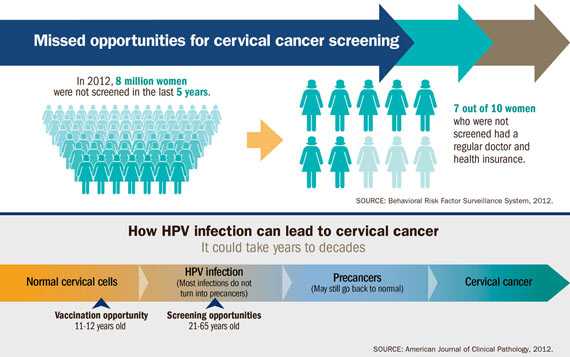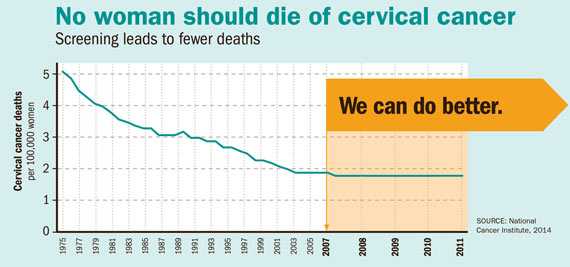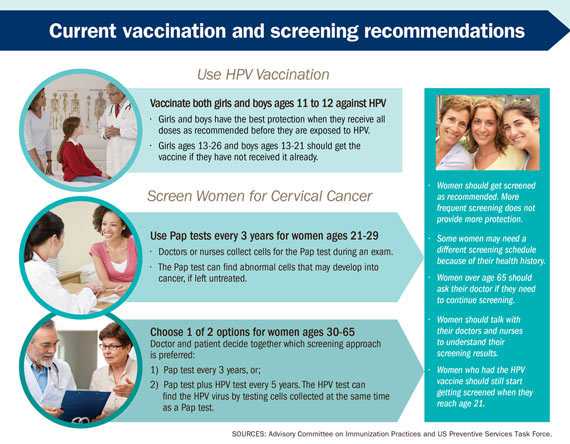Cervical Cancer is Preventable
November 2014


 4,000
4,000
More than 4,000 women die of cervical cancer each year.
 93%
93%
As many as 93% of cervical cancers could be prevented by screening and HPV (human papillomavirus) vaccination.
 8 Million
8 Million
In 2012, 8 million US women ages 21 to 65 reported they had not been screened for cervical cancer in the last 5 years.
More than 12,000 women get cervical cancer every year. Up to 93% of cervical cancers are preventable. Human papillomavirus (HPV) vaccination helps prevent infection with the HPV types that cause most cervical cancers. The Papanicolaou (Pap) test screens for abnormal cells that may develop into cancer and the HPV test screens for the HPV virus that causes these cell changes. Even though screening works, 10% of women in the US in 2012 reported they had not been screened in the last 5 years. Every visit to doctors and nurses is an opportunity to discuss cervical cancer prevention. No woman should die of cervical cancer.
Doctors, nurses, and health systems can:
- Help women understand what screening tests are best for them and when they should get screened.
- Screen or refer all women as recommended at any visit.
- Make sure patients get their screening results and the right follow-up care quickly.
- Use reminder-recall systems to help doctors, nurses, and patients remember when screening and HPV vaccination are due.
- Strongly recommend that preteens and teens get vaccinated against HPV.
Problem
Too many women have not been screened.
To prevent more deaths, screening efforts must continue.
- Widespread use of the Pap test led to dramatic declines in deaths from cervical cancer. Deaths from cervical cancer did not continue to decrease in the US from 2007 to 2011.
- The percentage of women screened decreased slightly from 2008 to 2010. The HPV vaccine can reduce risk of cervical cancer.
- HPV causes most cervical cancers.
- Only 1 in 3 girls and 1 in 7 boys had received the recommended 3 doses of the HPV vaccine in 2013.
- Adolescents are not getting HPV vaccination as often as other recommended vaccines, even though it is safe and effective.
Almost there: fewer missed opportunities can help get women ages 21 to 65 screened.
- More than 50% of all new cervical cancers are in women who have never been screened or have not been screened in the previous 5 years of their lives.
- About 7 in 10 women who have not been screened in the last 5 years have a regular doctor and had health insurance.

View larger image and read text description.

What Can Be Done
Federal government is
- Through the Affordable Care Act:
- Ensuring that most health plans cover cervical cancer screening as recommended at no additional cost to the patient.
- Ensuring that most health plans cover HPV vaccination as recommended for males and females at no additional cost to the patient.
- Helping people sign up for insurance coverage offered in the Health Insurance Marketplace.
- Investing in community health centers to expand women's access to health care services.
- Increasing access to immunizations through the Vaccines for Children (VFC) program.
- Supporting federal programs that increase cervical cancer screening rates. National Breast and Cervical Cancer Early Detection Program, Title X Family Planning
Doctors, nurses, and health systems can
- Help women understand which screening tests are best for them and when to get them.
- Screen or refer all women as recommended at any visit.
- Make sure patients get their screening results and the right follow-up care quickly.
- Use reminder-recall systems to help doctors, nurses, and patients remember when screening and HPV vaccination are due.
- Strongly recommend that preteens and teens get vaccinated against HPV.
Women can
- Learn about screening options and get the test that is right for them and follow-up on any abnormal results.
- Encourage other women to be screened for cervical cancer.
- Contact their local health department to learn how they can get screened for cervical cancer.
- Use every health care visit to ask if it's time to get screened.
- Get their sons and daughters vaccinated against HPV as recommended.
State and local public health can
- Encourage women to get screened by working with state Medicaid programs, community health centers, and community-based groups.
- Help women get screened, get medical appointments, and get treated as needed.
- Promote reminder-recall systems for screening and HPV vaccination.
- Promote recommended screening options and HPV vaccines to the public.
Science Behind the Issue
Related Pages
- Vital Signs Issue details: Cervical Cancer Incidence, Mortality, and Screening — United States, 2007–2012, Morbidity and Mortality Weekly Report (MMWR)
- Vital Signs – Cervical Cancer [PODCAST – 1:15 minutes]
- Vital Signs – Cervical Cancer [PSA – 0:60 seconds]
- Cervical Cancer
- Preteen and Teen Vaccines
- Human Papillomavirus (HPV)-Associated Cancers
- What Should I Know About Screening?
- National Breast and Cervical Cancer Early Detection Program
- Cervical Cancer [PDF – 874 KB]
On Other Web Sites
- Page last reviewed: November 5, 2014
- Page last updated: November 5, 2014
- Content source:
- National Center for Chronic Disease Prevention and Health Promotion, Division of Cancer Prevention and Control
- Page maintained by: Office of the Associate Director for Communications (OADC)


 ShareCompartir
ShareCompartir
